Outside YouTube, Inside Netflix: Bo Burnham and Contemporary Production Culture
Ben Rogerson / Texas Tech University

Bo Burnham’s 2021 Netflix comedy special Inside is aptly named. By almost exclusively showing the stand-up comedian shut within a small house, Inside would capture the experience of social distancing that defined the initial stages of the COVID-19 pandemic. This isolation turns into depression — Burnham lives too much “inside” his own head. Through a combination of musical performances, formal reflexivity and cringe confession, the special invites viewers to live inside his head too. Drawing on concepts from John Caldwell’s 2023 book Specworld, the concluding entry in his landmark trilogy, I want to explore how Burnham uses Inside to theorize about the self-management and exploitation of creative labor in the contemporary media industries. To that end, I contend that Inside functions as a career retrospective through which Burnham assesses the merits of the “warring creator pedagogies” shaping creative labor on premium platforms like HBO and Netflix and lesser ones like YouTube and Vimeo.
Burnham is no stranger to the career retrospective. In 2006, he got his start on YouTube, in an environment where “micro- or no-budget productions, hyperactive online uploading, low barriers to entry, [and] tangential monetization” were the emerging norms (Caldwell 85). Despite achieving crossover success shortly thereafter, Burnham did not try to erase his origins in what Caldwell would term “low-production culture,” but made it a routine point of reflection (85). For example, Zach Stone is Gonna Be Famous takes as its subject the “hungry” aspirant online creator—in the single season of this 2013 MTV mockumentary, Burnham plays a recent high-school graduate who is incurring the considerable costs of hiring a film crew to document his life, and all in the hopes that this gamble will launch him into stardom (113). Likewise, in his 2018 directorial debut Eighth Grade, which he also wrote, Burnham tells a coming-of-age story about a middle-school YouTuber.
Inside treads similar ground. By adopting the persona of YouTubers and Twitch gamers in comedy sketches, Burnham intensifies our awareness of the constraints that such platforms put on “low creators” (90). The opening song lyrics announce the polemic by presenting the constant algorithmic demand for low-production content as a form of infantilism: “I made you some content. Daddy made you your favorite. Open wide. Here comes the content.” If the platform push for nonstop uploading insults viewers, it also makes deleterious demands on low creators’ emotions. In one skit, presented as a “really quick video to say thank you,” an ebullient Burnham directly addresses the camera to enthuse about the enjoyment his content brings his subscribers. The joke is that for all this good cheer, Burnham punctuates his speech by repeatedly stabbing a steak knife at the camera. When this rage subsides, a numbness takes its place. Once Burnham says goodbye, the shot holds for fifteen seconds as the content creator continues to blankly stare at the camera, a smile on his face and the knife clutched in his hands (Fig. 2).
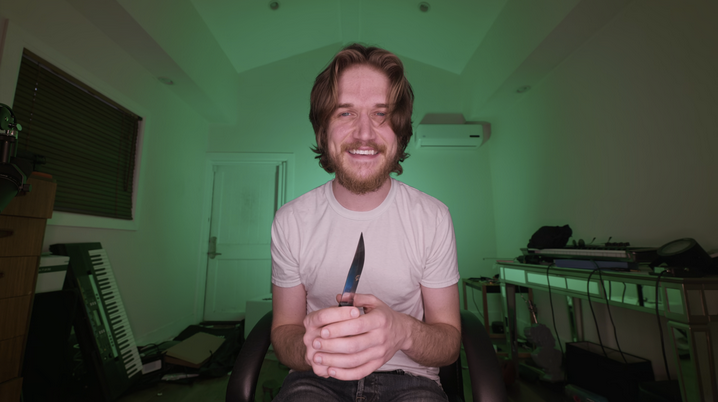
A forthright denunciation of low-production labor comes in “Unpaid Intern,” a song that describes the titular figure going on coffee runs, shuffling papers, and sitting silently in meetings, all for no money. In the follow-up “reaction video,” Burnham comments that “Unpaid Intern” concerns “the labor exploitation of the modern world.” So far, so good. The more interesting move is how Inside inscribes the stresses of low-production culture at a formal level — as more Burnhams pop up in more boxes, the reaction video becomes a reaction video about the reaction video, ad infinitum (Fig. 3). What the skit discloses is an important difference between high and low-production cultures. Jettisoning any “long, sequential production workflow,” the endless series of reaction videos exhibit the “abrupt singularity of ‘live’ everything” (Caldwell 101). When reactions are enough, why plan?
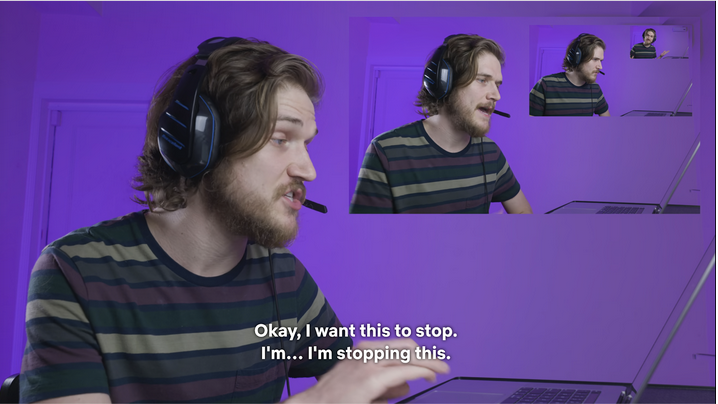
Of course, Inside has been planned. Burnham was not operating within the same micro-budgetary restraints as the aspirant YouTuber — his deal with Netflix was for $3.9 million. Put another way, the special is not a YouTube video, but a Netflix Original, an artifact dependent on preparation and pre-production, time and money. But at the same time, pandemic-era exigencies were disrupting the ways in which high-production culture customarily manages its workflow. To make the special, Burnham had to readopt some practices from his YouTube days. Multimillion-dollar deal aside, the production values of Inside were comparable to the high-end — the very high-end — of the do-it-yourself Youtuber ethic. Redditors and YouTubers painstakingly cataloged the equipment visible in the special and, as one gearhead puts it, “most of the stuff is surprisingly affordable,” prosumer-grade gear available for purchase on Amazon. The reencounter with low-production culture also concerned workspace. During the first eighteen months or so of the pandemic, Burnham resembled the typical YouTuber insofar as he was now also working from home in isolation and without a crew. There is, as Burnham tells his audience, “just me and my camera and you and your screen.”
While his previous string of successes meant that Burnham was turning his guest house, and not his bedroom, into an impromptu studio, Inside nevertheless treats these production conditions as if they were a sign that his career is taking a step backwards. Since his career started with him making YouTube videos in his bedroom, the entire point of crossover success was to escape such working conditions, an irony that is never lost on Inside. Consider the lyrics to “Look Who’s Inside Again”: “When you’re a kid and you’re stuck in your room / You’ll do any old shit to get out of it.” Tellingly, Inside cuts from this song to Burnham watching a wall projection of the 2006 YouTube video that catapulted him to stardom (Fig. 4). Burnham’s expressionless face conveys disapproval, laying bare the professional crisis of low-production culture: to make it, the YouTuber panders to viewer demands and, moreover, conforms his creative labor to satisfy the dictates of the platform.
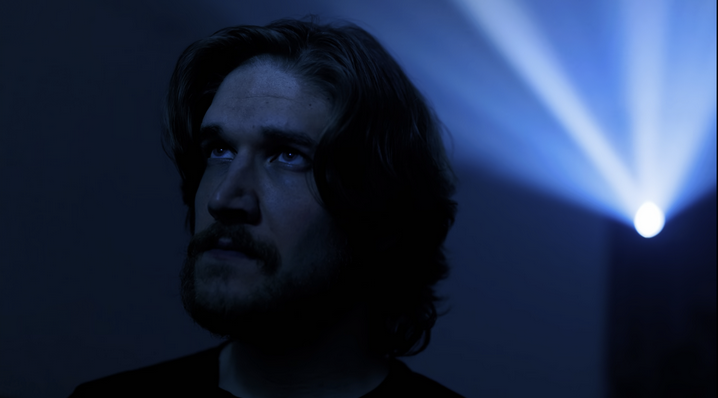
With my remaining space, what I want to briefly explore is how Inside deploys this DIY ethic to ratify a close relationship between creative autonomy and high-production culture. For example, Inside often invokes the ethic to flaunt its own “plodding” production pace and, by implication, to denigrate how low-production platforms compel the constant uploading of new content (Caldwell 100). “And instead of being filmed in a single night, [the special],” Burnham says, “will be filmed in uh, however long it takes to finish.” Compared to rapid-fire YouTube content, the special is disengaging—it is, in his own words, “fucking boring,” a point Inside reinforces in interstitial scenes that show our do-it-all comedian’s planning and preparation, his song outtakes and equipment tests (Fig. 5).
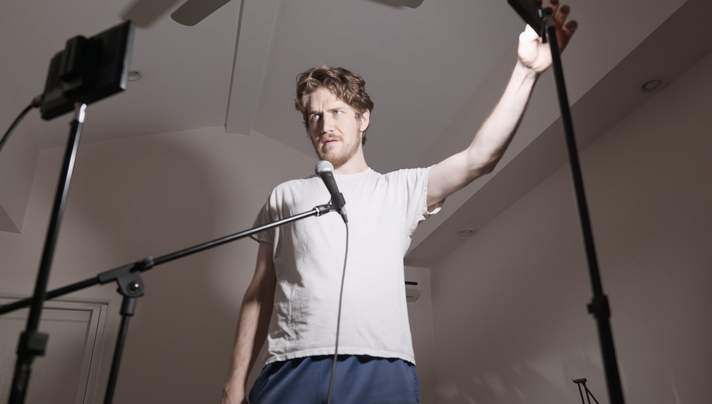
In the special’s final scenes, in which Burnham briefly escapes the room, Inside presumes to imply some form of creative autonomy by demonstrating professional indifference to the consumer demands that shape low-production culture. Outside, caught in a spotlight and confronted by the thunderous applause of an unseen audience, Burnham frantically struggles to reenter the guest house. The audience approves with riotous laughter. After a few moments of struggle, the quality of light suddenly changes — we are back inside the impromptu screening room, as the special has switched from the diegetic event to a projection of its recording. The scene rhymes with the previous screening of Burnham’s YouTube debut, though now his disapproving, deadpan expression sharply contrasts with the relentless laugh track. After more than ten seconds elapse, Burnham finally smirks at the scene outside, and the special immediately cuts to the end credits (Fig. 6). At last, Inside is finished, but only because this high-production artifact has finally satisfied the only audience that matters: the creator.
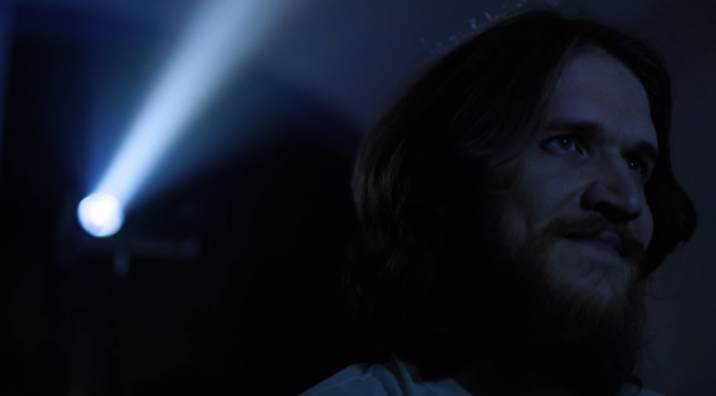
Image Credits:
- Inside (Burnham, 2021) as seen on Netflix. Source: author’s screenshot.
- A burned out Youtuber stares at the camera. Source: author’s screenshot.
- Reaction videos ad infinitum meet platform demands for constant content. Source: author’s screenshot.
- The high-production creator watches YouTube videos. Source: author’s screenshot.
- The high-production creator carefully tests equipment. Source: author’s screenshot.
- The end result satisfies the high-production creator. Source: author’s screenshot.
Caldwell, John. Specworld: Folds, Faults, and Fractures in Embedded Creator Industries. University of California Press, 2023.